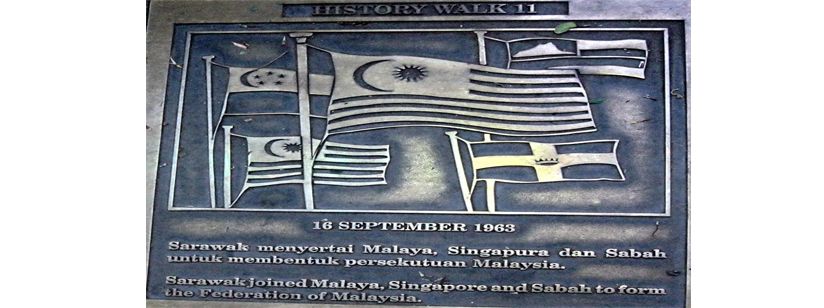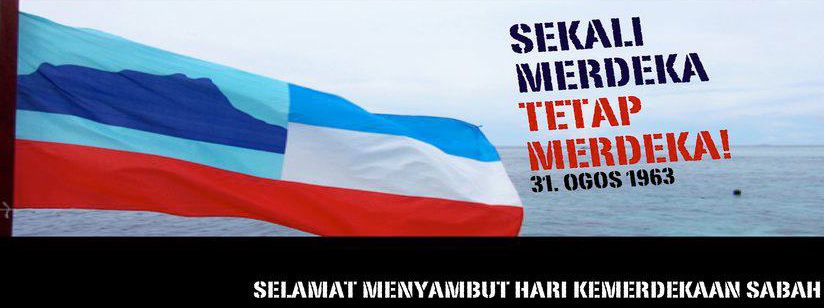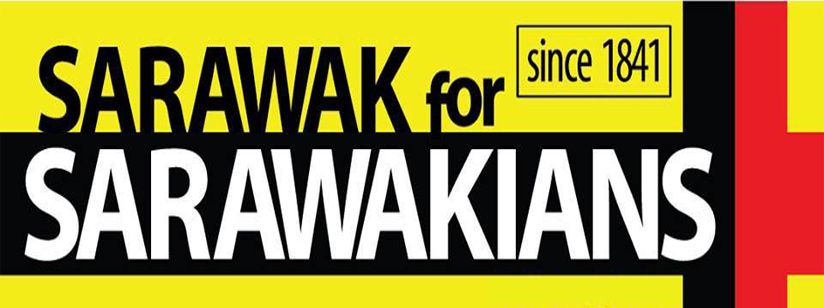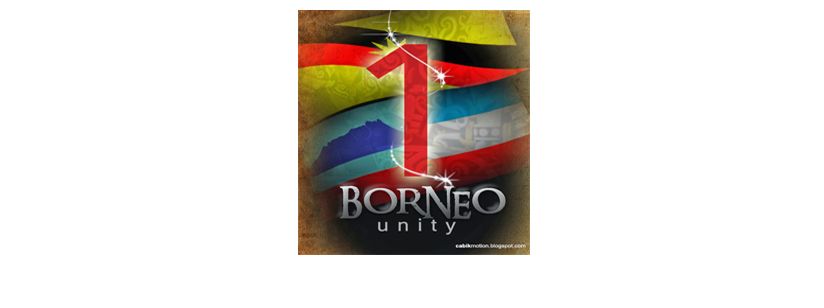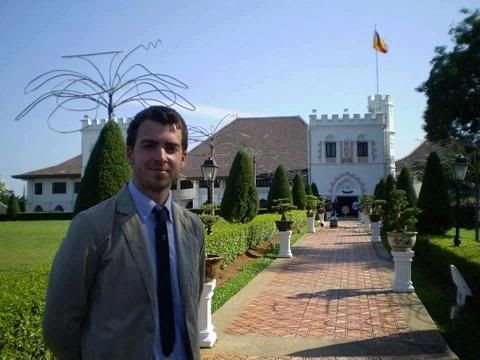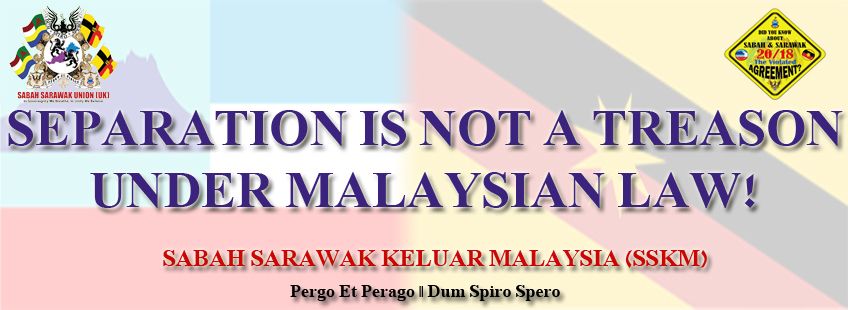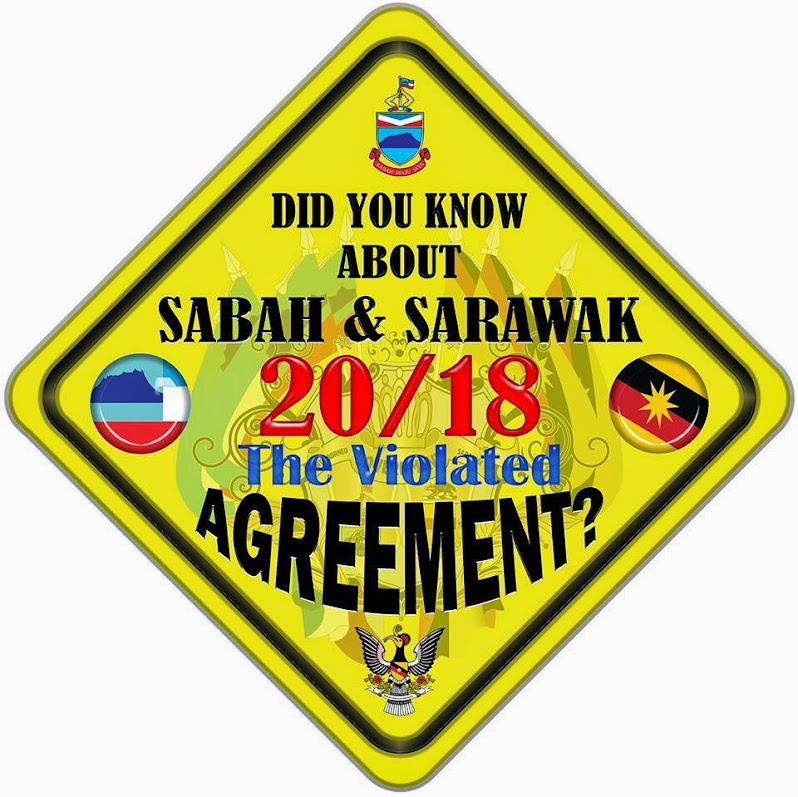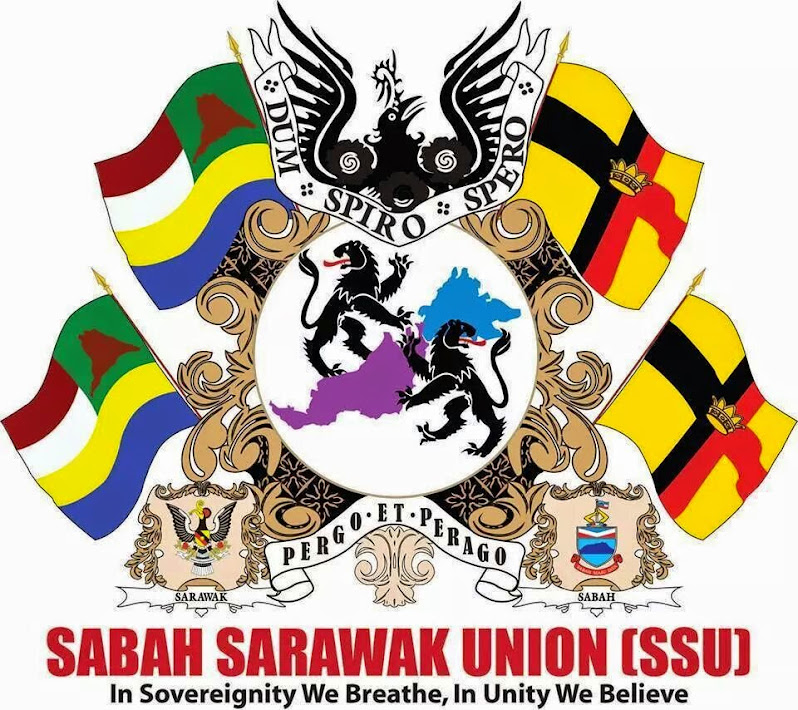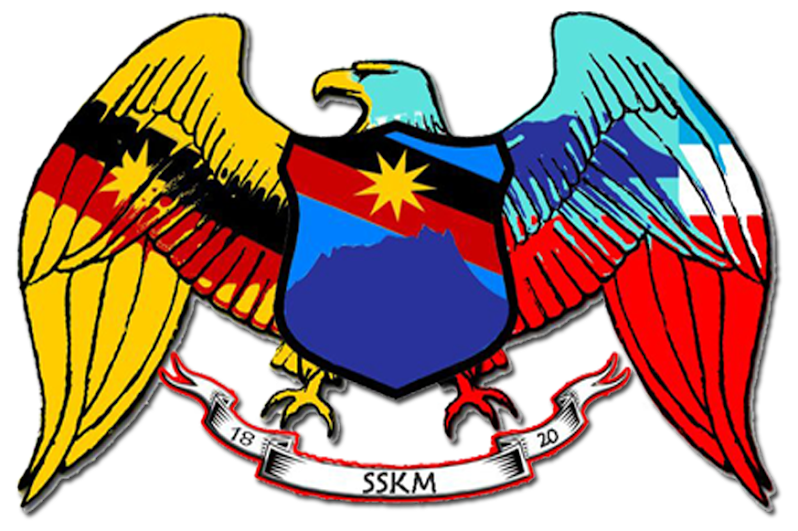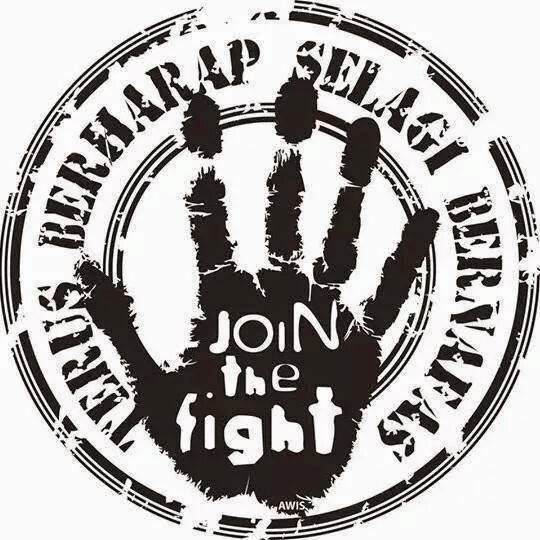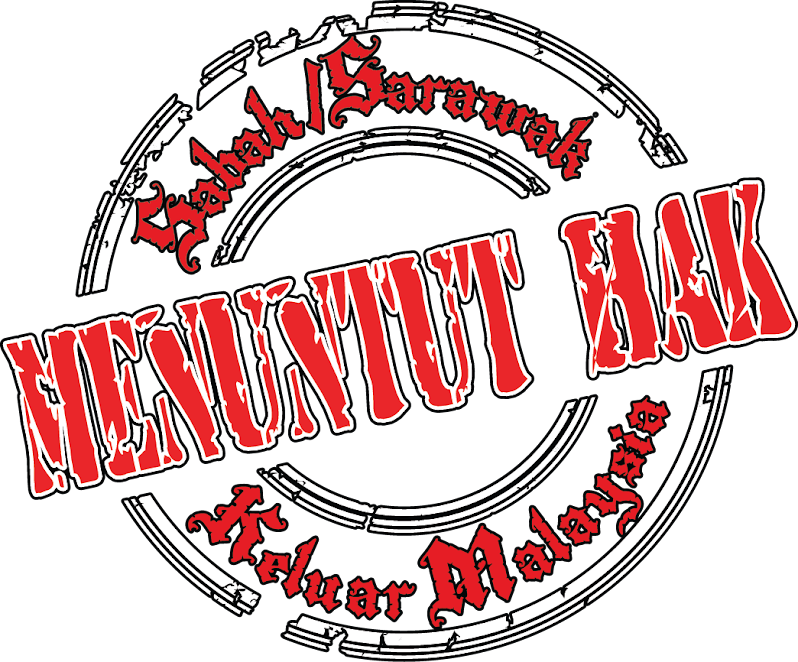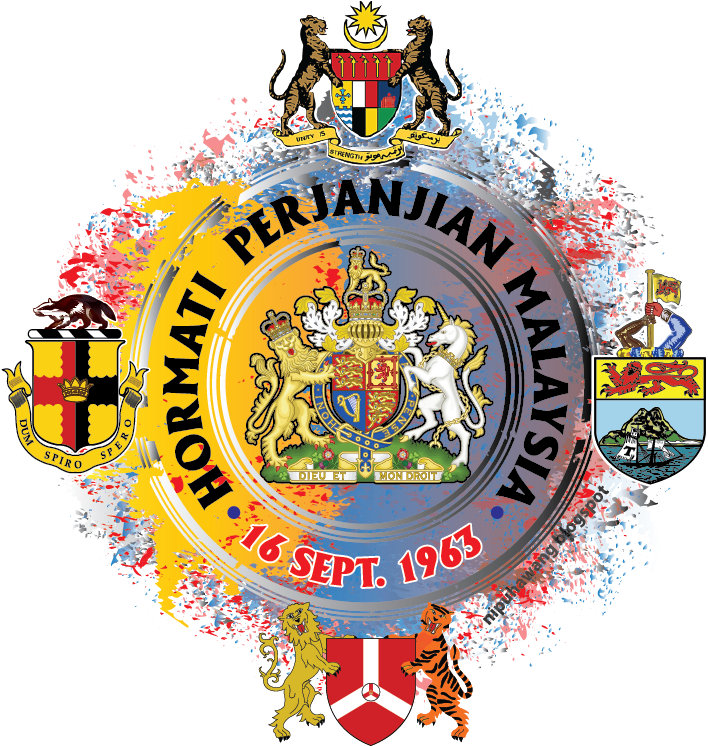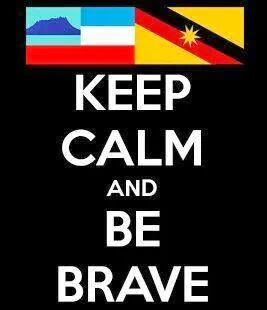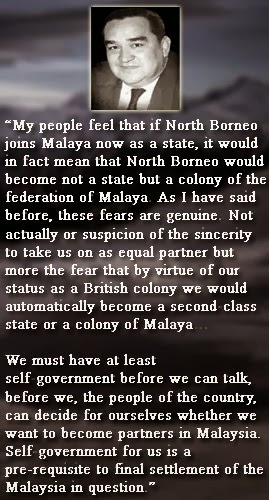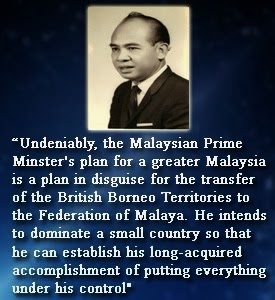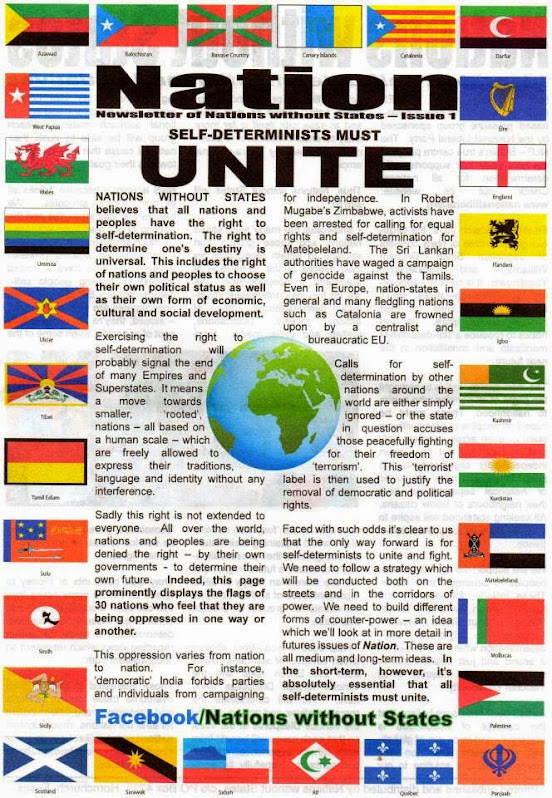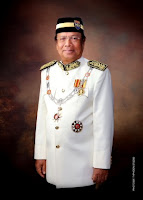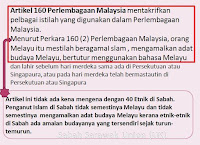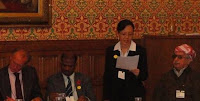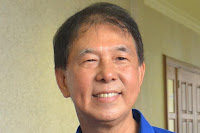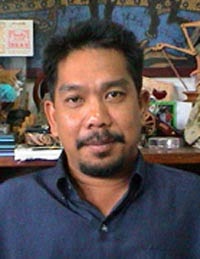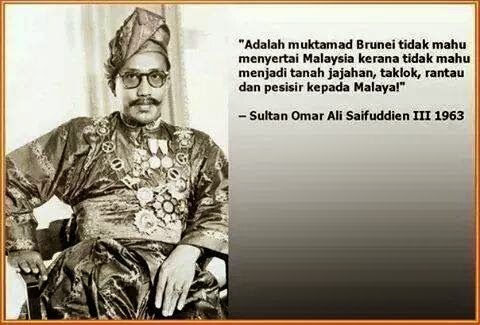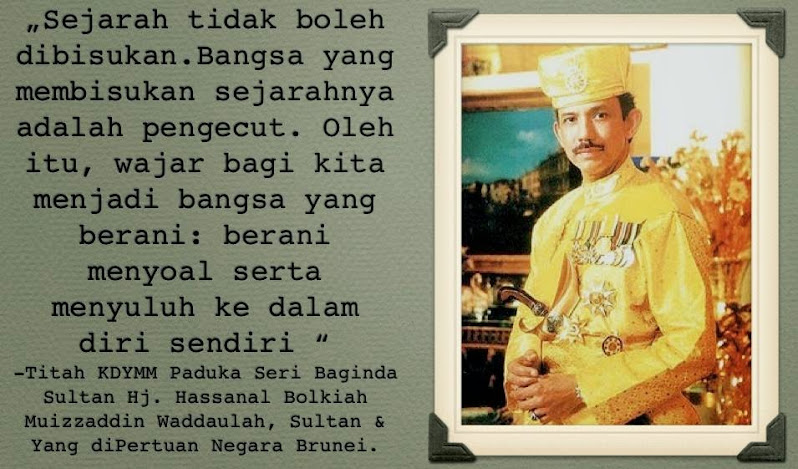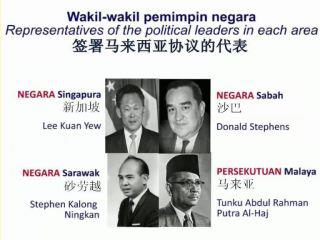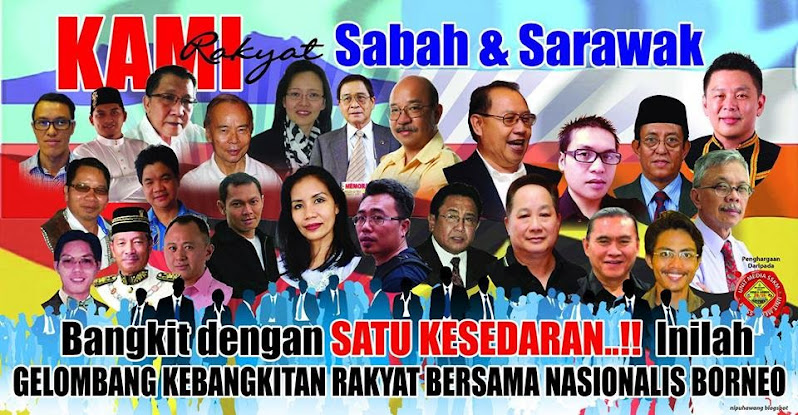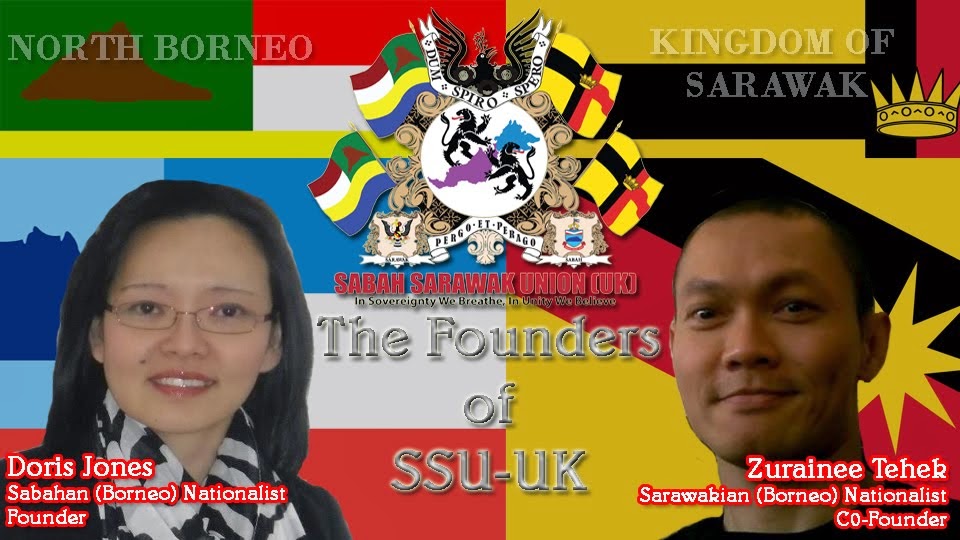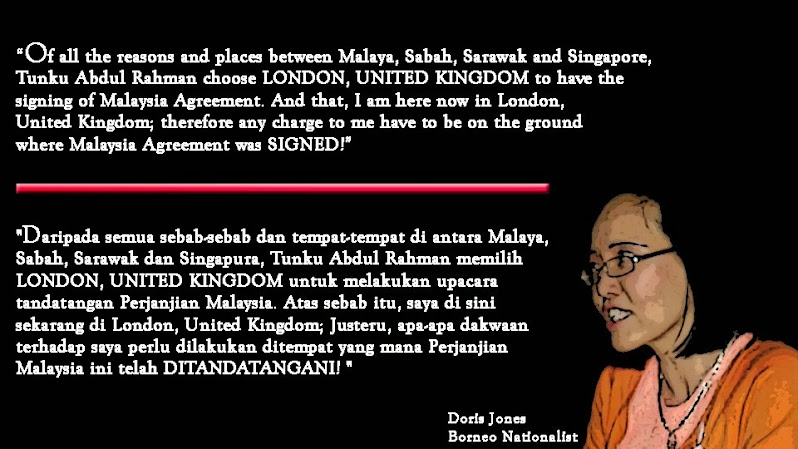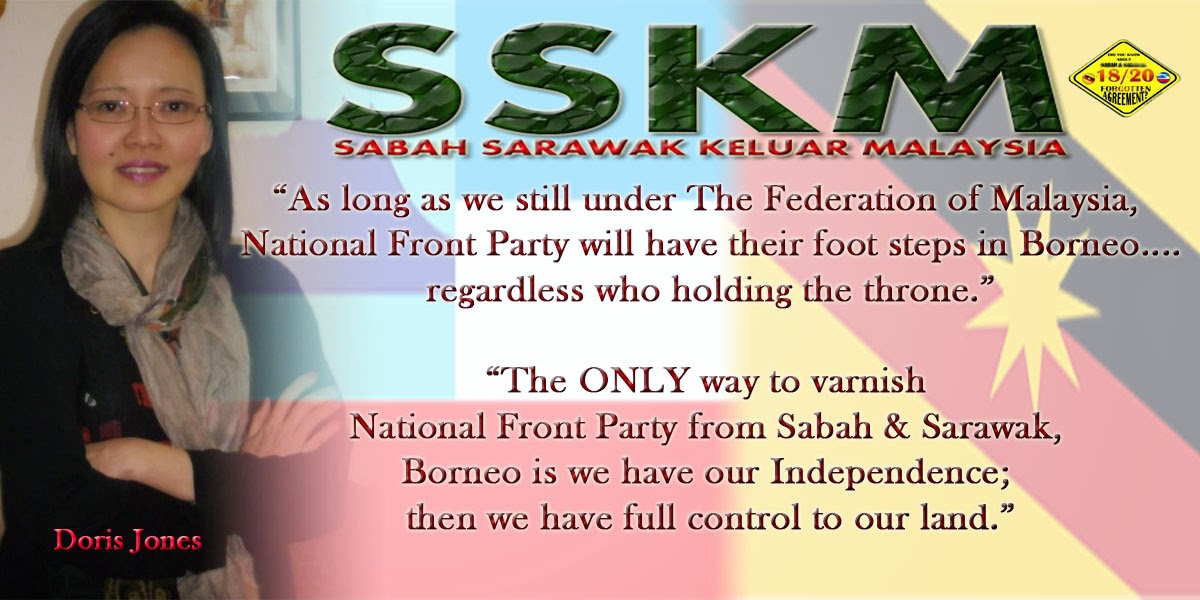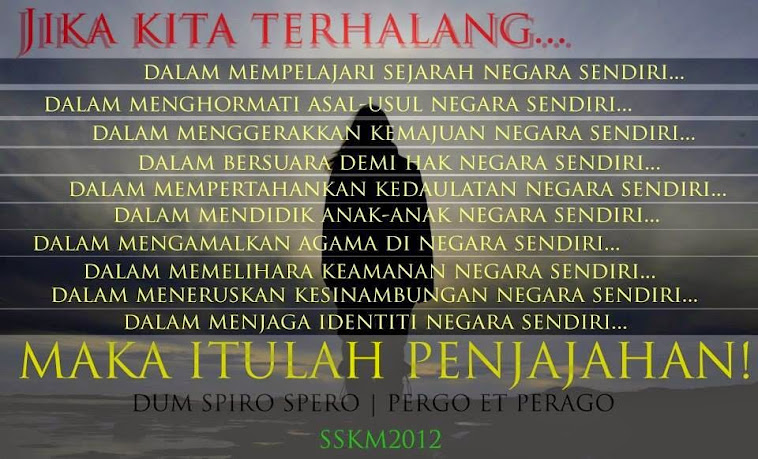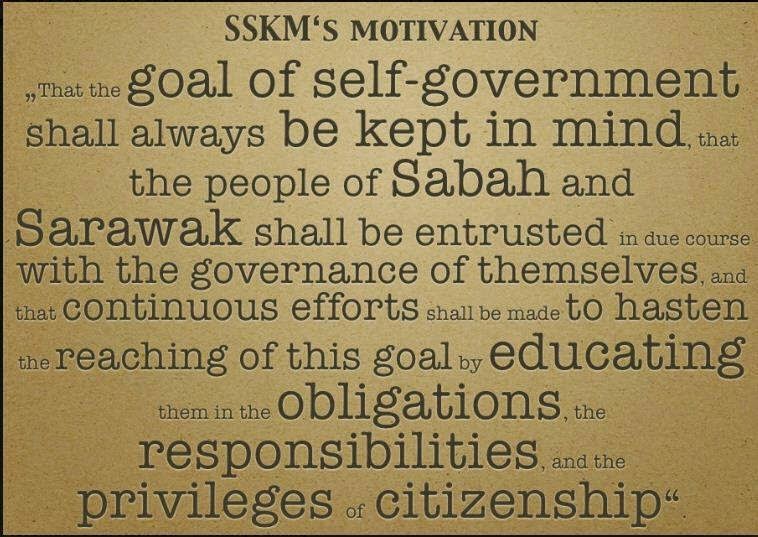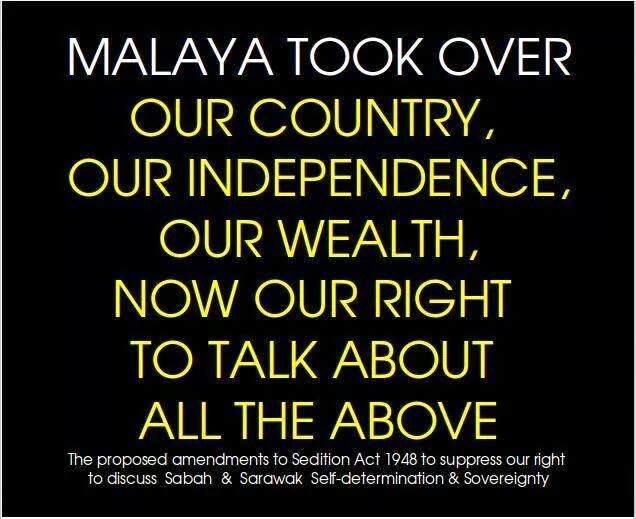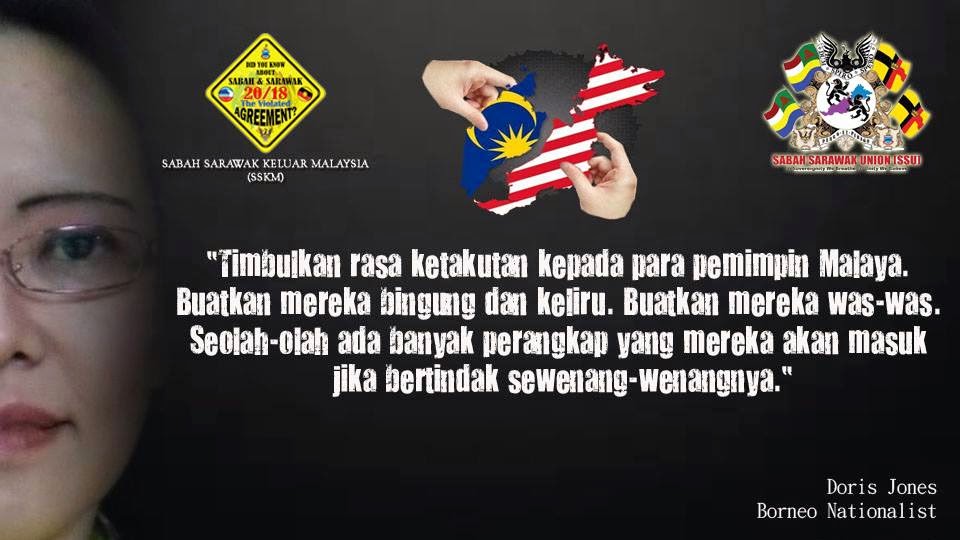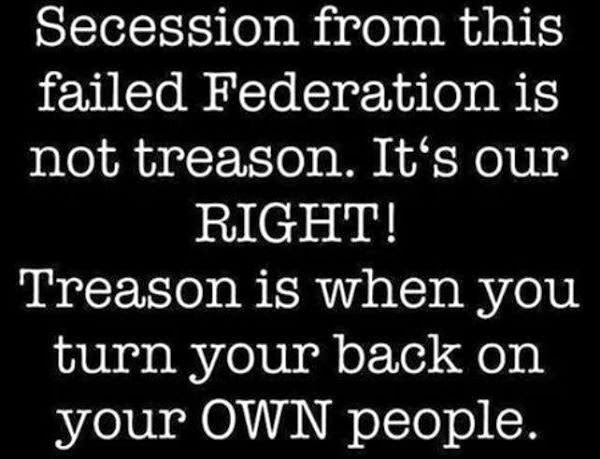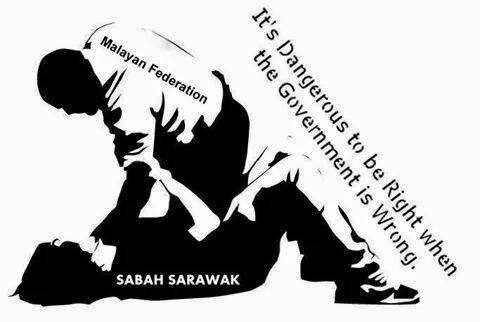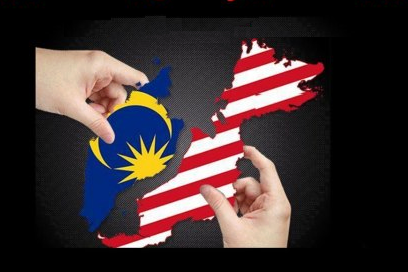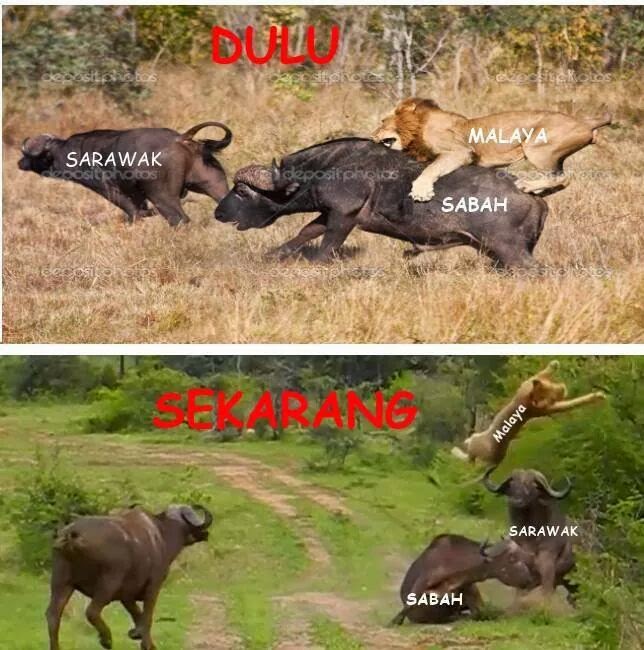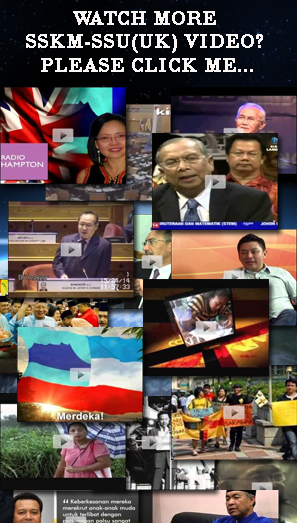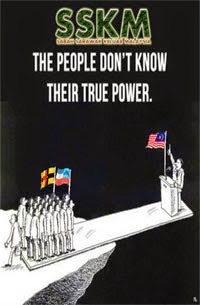Sunday, 19 July 2015
Pemimpin negeri sambut hari merdeka Sarawak pada 22 Julai
Yang Dipertua Negeri Tun Abdul Taib Mahmud dan Ketua Menteri Tan Sri Adenan Satem akan menghadiri acara khas bagi memperingati sejarah Sarawak Merdeka di Bangunan Dewan Undangan Negeri, Petra Jaya pada 22 Julai ini.
Menurut kenyataan Jabatan Penerangan hari ini, majlis itu akan dimulakan pada 10.30 pagi selepas ketibaan kedua-dua tetamu kehormat itu dan isteri mereka.
Semua tetamu lelaki dinasihatkan memakai sut atau jaket putih, pakaian kebangsaan atau tradisional masing-masing manakala tetamu wanita memakai baju kurung.
Acara itu akan menampilkan persembahan khas berkaitan detik bersejarah itu dan disusuli dengan ucapan Ketua Menteri, kata kenyataan itu.
Menteri-menteri Kabinet negeri dan Menteri-menteri Persekutuan, anggota-anggota Dewan Undangan Negeri, Anggota-anggota Parlimen, ketua-ketua jabatan kerajaan dan orang kenamaan juga akan menghadiri majlis itu.
Pada 22 Julai 1963, gabenor terakhir kerajaan British Sir Alexander Waddell meninggalkan Astana (kediamannya) dan menaiki sebuah sampan putih untuk menyeberangi Sungai Sarawak bagi menyerahkan kerajaan Sarawak kepada rakyatnya.
Hari bendera Union Jack diturunkan buat kali terakhir juga merupakan hari mesyuarat Kabinet negeri pertama, yang dipengerusikan Ketua Menteri pertama Datuk Stephen Kalong Ningkan, diadakan.
Sarawak kemudian menyertai Sabah, Malaya dan Singapura untuk membentuk Malaysia pada 16 September 1963. – Bernama, 19 Julai, 2015.
Taib, Adenan to attend Sarawak Independence Day event on July 22
Yang Dipertua Negeri Tun Abdul Taib Mahmud and Chief Minister Tan Sri Adenan Satem will attend a special event to commemorate Sarawak Independence Day, which falls on July 22. at the State Assembly building in Petra Jaya.
According to a statement from the State Information Department, the ceremony is expected to start at 10.30am upon the arrival of the two guests of honour and their spouses.
All male guests have been advised to wear white lounge suit or put on a white blazer or they may choose to wear their national or traditional attire while the ladies will have to wear the "baju kurung".
The essence of the event will be a special rendition relating to the historic moment followed by a speech by Adenan, said the statement.
State cabinet ministers and federal ministers, state assemblymen, members of parliament, heads of government departments and other dignitaries will also attend the event.
On July 22, 1963, the last governor of the British Government, Sir Alexander Waddell, left the Astana, his residence, and boarded a white sampan to cross the Sarawak River to hand over the Government of Sarawak to its own people.
The day that the Union Jack was lowered for the last time was also the day that the first state cabinet meeting, presided over by first chief minister Datuk Stephen Kalong Ningkan, was held.
Sarawak later joined Sabah, Malaya and Singapore, on September 16, 1963, to form Malaysia. – Bernama, July 19, 2015.
"Sarawak was granted self-government on 22 July 1963"
To West Malaysia people, there's something you all need to know before say something about Sarawak Independence day, why we reject August 31, you need to know one thing...
Sarawak was granted self-government on 22 July 1963...
William Liam (right photo)
Forgotten in the past, appeared to be a pointed reminder to the national government in Putrajaya that elements in both Sabah and Sarawak are demanding a more assertive approach to the governance of their own affairs.
The British took over the role of protecting Sarawak in 1888, formally becoming a colony in July 1946. On 22nd July 1963 Britain granted Sarawak full independence, where it became a sovereign state in its own right.
Many, if not most Malaysians are unaware that Sarawak was indeed, if only for a short time, a fully independent state before it entered into the Malaysia Agreement to form the Federation of Malaysia along with Sabah, Malaya, and Singapore, which formally came into effect on 16th September 1963, the actual birth date of Malaysia. Sarawak’s status, like Sabah’s within the Federation was defined by the 18 Points Agreement, which gave Sarawak (20 points in Sabah) sole responsibility in governing many aspects of its territory.
There is a sentiment in many quarters within Sarawakian society that the state’s rich and diverse history has been lost in favor of the ‘national Merdeka’ narratives dominated by the stories of the independence movement within the Malay Peninsula. As a consequence, Liberation Day, as independence from Britain is called in Sarawak, has become a forgotten annal in Malaysia’s history.
SUPP sec gen: Don’t forget importance of July 22
MIRI: Sarawakians, especially youths, are urged not to forget an important date in the state’s history, which is July 22, 1963.
SUPP secretary general Datuk Sebastian Ting said knowledge about the history of Sarawak will further instil Sarawakians with love for the state.
“This date must be remembered, because many do not know how important this date is for our state. This is the date we gained our freedom from the Bristish,” he said.
Ting, who is also SUPP Piasau chairman, said the date is among the three important dates which all Sarawakians must know.
The first date he said, is August 31, 1957 which is the Independence Day of Malaya before the date was made the National Day for all Malaysians.
Apart from Sarawak’s independence day, another date to be remembered is September 16, 1963 which is the date of the formation of Malaysia.
“SUPP was set up to fight for the right of every race and the rights of the people of Sarawak. So we will continue to fight for this,” he stressed.
Among SUPP Miri’s efforts to remember Sarawak Independence Day is the printing of t-shirts with the words ‘I AM Sarawakian’ to be distributed for free to some 200 party members.
He added that they will be printing more of the t-shirts in order to promote the important date.
SUPP launched its slogan ‘SUPP For Sarawakian’ last June and has been distributing car stickers bearing the slogan as part of its campaign to remember Sarawak’s independence day.
Cerita tentang Johor yang merdeka dari Putrajaya
Semasa saya kecil, setiap kali Aidilfitri, keluarga saya akan menyambut hari raya di Kluang, Johor.
Semasa itu, rumah nenek masih rumah kayu, suasana kampung masih wujud lagi, dan masih kelihatan ayam itik dan lembu di sekeliling rumah.
Tapi itu kira-kira 20 tahun yang lalu. Sekitar tahun 1997, kawasan kampung ini disodok dan dijadikan kawasan perumahan untuk golongan menengah rendah di Kluang.
Sementara itu, orang-orang Kampung Bentong Luar (nama kampung saya) dipindahkan ke satu kawasan perumahan teres di Taman Sri Kluang.
Sejak itu, keluarga saya jarang pulang ke Kluang. Mereka lebih selesa berhari raya di rumah sendiri.
Tetapi tahun ini, saya mengambil keputusan untuk berhari raya di Kluang, walaupun keluarga saya tidak ikut sekali.
Ini kerana saya mahu menziarah kubur arwah nenek saya yang meninggal dua tahun yang lepas.
Biasanya jika saya balik berhari raya di Johor, saya mengelak daripada bercakap tentang politik, kerana saya tahu pegangan politik saya sangat berbeza dengan orang kampung.
Kampung saya ini kubu kuat Umno sejak, hmmm..., entah sejak bila tapi setahu saya ia memang selamanya kubu Umno.
Tetapi kali ini orang kampung saya melihat pemerintahan Datuk Seri Najib Razak yang lembik dan teruk, selain faktor GST yang membuatkan mereka marah, banyak isu-isu panas yang gagal diuruskan oleh pentadbiran Najib.
Tapi dalam masa sama mereka kurang percaya yang Pakatan Rakyat boleh jadi kerajaan persekutuan yang baik.
Sebaliknya, mereka melihat satu alternatif yang lain – Johor keluar dari Malaysia dan membentuk sebuah negara sendiri, seperti Brunei Darussalam, mungkin.
Pada kali pertama saya mendengar perkara ini, saya tergelak perkara ini kerana benda ini agak mengarut.
Tetapi sentimen ini diterjemahkan oleh mereka tanpa disedari. Mereka menyampaikan ketidakpuasan hati mereka kepada Putrajaya melalui cara mereka berfikir, berpakaian atau bercakap.
Mungkin mereka tidak sedar – tetapi mengikut pemerhatian saya, saya merasakan mereka lebih rela memakai jersi JDT daripada jersi pasukan Malaysia. Tapi itu perkara yang kecil.
Tapi perkataan-perkataan yang dahulunya saya jarang dengar seperti "Bangsa Johor", sudah mula kedengaran di mana-mana.
Sticker-sticker berlandaskan semangat kenegerian berada di mana-mana kereta dan motosikal. Jenama baju Joho, baju tertulis perkataan "Johor" dalam tulisan jawi, atau sticker seperti "Lanun Johor" kelihatan di mana-mana, tidak mengira kaum.
Johor yang saya kenal semasa saya kecil dahulu, bukan Johor yang macam sekarang.
Mungkin selama ini negeri yang agak kuat semangat kenegeriannya seperti Kelantan atau Sabah sudah biasa saya lihat, tapi semangat kenegerian Johor ini seolah-olah ia secara "subliminal message" ini adalah "nasionalisme Bangsa Johor" dan ia lebih kuat dari apa yang saya fikirkan sebelum ini.
Yang paling saya tak tahu selama ini negeri Johor ada bendera-bendera daerah mereka sendiri.
Saya tak pernah bayangkan Hulu Langat atau Petaling ada bendera sendiri di Selangor.
Itu mungkin perkara kecil. Tapi, dari perkara kecil lah, benda besar boleh berlaku.
Peristiwa rusuhan di Plaza Low Yat misalnya, bermula dari perkara kecil – curi telefon bimbit (atau peniaga menipu barang kepada pengguna, tak tahu yang mana satu betul) – tapi lama-lama ia menjadi besar, dan jika tidak dikawal ia jadi satu rusuhan kaum yang besar seperti 13 Mei 1969.
Jadi "perkara-perkara kecil" inilah yang saya perhatikan di Johor. Jika pentadbiran di Putrajaya masih lagi kalut, dan pembangkang masih berkelahi sesama sendiri, lama-lama saya rasa gerakan untuk keluar dari Malaysia akan semakin kuat.
Bahkan saya percaya rata-rata rakyat Johor lebih percaya dan lebih menyokong Sultan dan Tengku Mahkota Johor dari perdana menteri Malaysia.
Kalau berterusan begini, mungkin satu hari nanti bila saya nak pulang berhari raya ke rumah saudara mara saya di Kluang ini, saya terpaksa membawa passport.
Apapun, saya ingin mengucapkan Selamat Hari Raya Aidilfitri kepada semua pembaca ruang pojok ini, dan semua pembaca The Malaysian Insider. Saya memohon ampun dan maaf sekira sepanjang tahun yang lalu saya ada terkasar bahasa dan menimbulkan kemarahan. – 18 Julai, 2015.
Saturday, 18 July 2015
Saturday, July 18, 2015
Doris Jones
,
Exposing the Truth
,
News
,
Official Statement
,
Sabah
No comments
Majoriti Orang Islam Di Negara Sabah Bukan Orang Melayu
"Ia sebenarnya merupakan satu strategi manipulasi propaganda politik bn-umno yang kotor kerana ia bersembunyi disebalik nama etnik dan agama" ujarnya. Tegas beliau, "definisi perlembagaan ini tidak boleh digunapakai di Borneo iaitu di negara Sabah dan negara Sarawak. Ini kerana, definisi ini hanya dihadkan atau merangkumi kepulauan tanah melayu sahaja iaitu di malaya."
LONDON, 17 Julai 2015: Doris Jones telah mempersoalkan tentang takrifan "melayu" mengikut definisi perlembagaan persekutuan malaya yang juga dikenali sebagai perlembagaan persekutuan malaysia.
Didalam pos beliau, perkongsian mengenai takrifan ataupun definisi "melayu" telah menyatakan bahawa didalam Artikel 160 Perlembagaan Malaysia menurut Perkara 160 (2), orang melayu itu mestilah beragama Islam, mengamalkan adat budaya Melayu, bertutur menggunakan bahasa Melayu dan lahir sebelum hari merdeka sama ada di Persekutuan atau Singapura, atau pada hari merdeka telah bermastautin di Persekutuan atau Singapura.
Beliau menerangkan bahawa takrifan ataupun definisi tersebut adalah tidak kena mengena dengan lebih 40 etnik di negara Sabah. Penganut Islam di negara Sabah tidak semestinya melayu dan tidak semestinya mengamalkan adat budaya melayu kerana etnik-etnik di negara Sabah memiliki amalan adat dan budayanya sendiri sejak turun-temurun lagi.
Didalam penjelasan ini, beliau telah menjelaskan lagi bahawa sebenarnya rakyat negara Sabah telah dikelirukan dan disesatkan oleh pemimpin-pemimpin barisan nasional dan umno yang ingin mendapatkan sokongan daripada rakyat negara Sabah yang beragama Islam melalui definisi perlembagaan ini yang kononnya melayu di negara Sabah harus menyokong perjuangan politik barisan nasional dan umno kerana perjuangan ini adalah untuk menjaga kepentingan mereka.
"Ia sebenarnya merupakan satu strategi manipulasi propaganda politik bn-umno yang kotor kerana ia bersembunyi disebalik nama etnik dan agama" ujarnya. Tegas beliau, "definisi perlembagaan ini tidak boleh digunapakai di Borneo iaitu di negara Sabah dan negara Sarawak. Ini kerana, definisi ini hanya dihadkan atau merangkumi kepulauan tanah melayu sahaja iaitu di malaya."
"Kebenaran kenyataan ini dapat dibuktikan dengan jelas sekali melalui definisi "persekutuan" perlembagaan malaysia itu sendiri", ujarnya. "Persekutuan" melalui definisi perlembagaan malaysia adalah merujuk kepada "persekutuan yang dibentuk pada tahun 1957" iaitu pada 31 Ogos 1957 yang mana kerajaan persekutuan tanah melayu (malaya) telah mendapat kemerdekaan daripada kerajaan British.
Oleh itu, beliau telah menyeru kepada semua etnik-etnik Orang Asal Sabah (Natives Sabahan) khususnya agar tidak diperbodohkan dan tidak disesatkan melalui kefahaman songsang ini. Setiap etnik di negara Sabah yang beragama Islam dan berada didalam kategori Orang Asal seperti Kadazan, Dusun, Murut, Rungus, Bajau, Suluk, Tidung, Ubian, Sungai dan seterusnya haruslah bertanggungjawab didalam menjaga identiti etnik dan kebudayaan mereka masing-masing. Ini kerana, sebarang pengakuan ataupun deklarasi yang mengatakan diri mereka adalah etnik "melayu" di negara Sabah, dengan secara automatiknya, mereka akan terkeluar daripada senarai Orang Asal dan ini secara langsung, mereka tidak berhak untuk mendapatkan keistimewaan yang telah diperuntukkan dan dikhaskan kepada Orang Asal (Natives) didalam Perlembagaan Negara Sabah.
Ini kerana, perlembagaan negara Sabah tidak mengiktiraf melayu sebagai Orang Asal negara Sabah. Melayu adalah berada didalam kategori "Orang Bukan Asal ataupun Non-Natives".
Maka, melalui laporan statistik kependudukan negara Sabah yang telah mencatatkan peningkatan "melayu" di negara Sabah mesti dikecualikan daripada memperolehi hak-hak Orang Asal kerana mereka tergolong didalam kategori "Bukan Orang Asal ataupaun Non-Natives". Segala pemilikan tanah yang diperolehi atas nama Orang Asal haruslah ditarik balik.
Namun, jikalau mereka yang berada didalam kategori "melayu" ini telah menukar semula status etnik mereka kepada etnik sebenar mereka yang terdiri daripada Kadazan, Dusun, Murut, Rungus, Bajau, Suluk, Tidung, Ubian dan seterusnya, maka mereka berhak untuk mengekalkan keistimewaan tersebut.
Apabila ditanya tentang kenyataan beliau ini, ia mengatakan bahawa beliau termasuk dengan pemimpin-pemimpin yang berjiwa Patriotik sedar bahawa terdapat usaha-usaha kotor, hina dan jijik daripada kerajaan persekutuan malaya yang telah menyamar menjadi kerajaan persekutuan malaysia melalui sokongan barua-barua malaya yang ingin memalayunisasikan etnik-etnik Orang Asal Sabah yang beragama Islam.
Katanya, "adalah menjadi tanggungjawab sepenuhnya untuk setiap rakyat negara Sabah yang sedar akan strategi politik bn-umno yang kotor, hina dan jijik ini dihentikan sepenuhnya melalui kerjasama setiap etnik Orang Asal (natives) Sabah. Ini kerana, kita tidak mahu kehilangan mana-mana etnik-etnik Orang Asal negara Sabah. Kita mahu mempertahankan identiti, adat dan kebudayaan mereka tanpa sebarang penyesatan identiti mereka kerana itulah keunikan setiap etnik di negara Sabah. Jikalau tidak, etnik Orang Asal yang beragama Islam ini akan hilang ditelan oleh pengkhianat-pengkhianat bangsa negara Sabah yang mempunyai kepentingan politik semata-mata."
Beliau menegaskan bahawa "kenyataan ini adalah berdasarkan kepada sudut perundangan Perlembagaan negara Sabah dan Perlembagaan Persekutuan Malaysia. Tambahannya lagi, jika ada sesiapa merasakan bahawa maklumat ataupun penerangan yang diberikan ini adalah salah, sila kemukakan hujah dengan kenyataan yang kukuh".
Laporan ini disampaikan oleh Reporter Borneo Nationalist.
Saturday, July 18, 2015
Doris Jones
,
Exposing the Truth
,
News
,
Official Statement
,
Sabah
,
Sabah Sarawak Union (SSU)
,
Sarawak
,
SSKM
No comments
Negara Sabah dan Negara Sarawak Tidak Terikat Dengan Perlembagaan Persekutuan Malaysia
LONDON, 17 Julai 2015: Doris Jones yang merupakan pemimpin kepada sebuah organisasi sosial didalam Facebook yang bernama Sabah Sarawak Keluar Malaysia (SSKM) yang kini sudah berdaftar secara sah dibawah bidang kuasa perundangan United Kingdom of Great Britain and Northern Ireland (UK) dengan nama Sabah Sarawak Union (SSU-UK) telah menimbulkan beberapa persoalan tentang kesahihan perlembagaan persekutuan malaysia sehingga menjadi perbualan yang hangat dikalangan pengguna sosial halaman Facebook.
Didalam kenyataannya, beliau mempersoalkan tentang bagaimana Sabah mahupun Sarawak boleh tertakluk kepada perkara-perkara dalam Perlembagaan yang diwujudkan sebelum pembentukkan Malaysia.
Menurutnya, Perlembagaan Malaysia yang juga dikenali sebagai Perlembagaan Persekutuan mengandungi 183 Perkara adalah merupakan undang-undang yang tertinggi di Malaysia. Namun, ujarnya, ia sebenarnya merupakan satu dokumen undang-undang bertulis yang telah dibentuk berasaskan kepada dua dokumen terdahulu iaitu Perjanjian Persekutuan Tanah Melayu 1948 dan Perlembagaan Persekutuan Tanah Melayu yang telah merdeka pada tahun 1957.
Penjelasan kepada kenyataannya menerangkan bahawa sebelum terbentuknya Persekutuan Malaysia, sebuah Perlembagaan Baru Persekutuan Malaysia yang dibentuk pada tahun 1963 perlulah diwujudkan seperti mana yang disarankan didalam laporan Inter-Governmental Committee (IGC) namun pemimpim kerajaan persekutuan tanah melayu (malaya) pada ketika itu yang diketuai oleh Tunku Abdul Rahman telah mencadangkan untuk menggunakan terlebih dahulu Perlembagaan Kerajaan Persekutuan Tanah Melayu sementara sebuah perlembagaan baru akan diwujudkan nanti. Namun, sehingga kini, perlembagaan baru tersebut tidak pernah wujud.
Tambahannya lagi, Perlembagaan Persekutuan yang wujud sekarang sebenarnya adalah Perlembagaan asal Persekutuan Tanah Melayu (Malaya) yang diwujudkan sebelum malaya mencapai kemerdekaannya pada 31 Ogos 1957. Beliau juga berkata, ini dapat dibuktikan dengan jelas bahawa definisi "Persekutuan" itu sendiri telah membawa maksud "Persekutuan yang dibentuk pada tahun 1957".
Persoalan yang timbul daripada definisi tersebut ialah, adakah negara-negara di Borneo pada ketika itu iaitu North Borneo (kini negara Sabah) dan negara Sarawak telah menyertai Persekutuan Tanah Melayu? Jawapannya adalah Tidak, katanya.
 Beliau menegaskan lagi bahawa pada ketika malaya mencapai kemerdekaannya, negara North Borneo dan negara Sarawak masih lagi merupakan Tanah Jajahan Makhota British sehingga pada tahun 1963. Jadi, dimanakah logiknya kesahihan akan penggunaan perlembagaan ini, ujarnya.
Beliau menegaskan lagi bahawa pada ketika malaya mencapai kemerdekaannya, negara North Borneo dan negara Sarawak masih lagi merupakan Tanah Jajahan Makhota British sehingga pada tahun 1963. Jadi, dimanakah logiknya kesahihan akan penggunaan perlembagaan ini, ujarnya.
Definisi "Persekutuan" menurut Perlembagaan negara Sabah dan negara Sarawak memberikan pengertian "Persekutuan yang dibentuk semasa dan selepas Malaysia Day". Malaysia Day yang dimaksudkan didalam Perlembagaan kedua-dua negara Borneo ini adalah merujuk kepada tarikh terbentuknya Persekutuan Malaysia melalui Deklarasi Rasmi pada 16 September 1963. Beliau mempersoalkan lagi tentang bagaimana definisi "persekutuan" ini saling bercanggah antara satu sama yang lain.
Dalam erti kata lain, beliau menegaskan bahawa jikalau undang-undang yang tertinggi ini sudah memberikan definisi yang salah, maka perjuangan Sabah Sarawak Union (SSU-UK) adalah sah disisi undang-undang didalam mempersoalkan kesahihan perlembagaan dan pada masa yang sama perjuangan kearah kemerdekaan sebenar negara Sabah dan negara Sarawak melalui perpisahan daripada persekutuan malaysia adalah tidak menyalahi undang-undang sama sekali. Ini juga jelas dinyatakan didalam laporan Cobbold Commission yang mengatakan bahawa "mana-mana negara yang menyertai persekutuan ini dengan secara sukarela mempunyai hak intrinsik (hak dalaman) untuk berpisah daripada persekutuan jikalau mereka mendapati bahawa persekutuan ini tidak memberikan manfaat kepada mereka". Kenyataan ini dikeluarkan sendiri oleh Lord Cobbold dan disokong sepenuhnya oleh Sir Landowsne dengan tidak memasukkan larangan berpisah didalam Perjanjian Malaysia yang telah ditandagani pada 9 Julai 1963.
Laporan ini disampaikan oleh Reporter Borneo Nationalist.
S4S desak Ketua Polis Sarawak letak jawatan
Negara Sarawak: Gerakan 'Sarawak For Sarawakian' (S4S) mendesak Ketua Polis Sarawak agar meletak jawatan berikutan larangan perarakan yang bakal diadakan pada 22 Julai ini.
Menurut status laman sosial Facebook salah seorang ketua gerakan S4S ini, Datuk Muhammad Sabtu mesti meletak jawatan diatas ketidakcekapan beliau dalam menjalankan tugas dan ia memberi imej buruk kepada PDRM.
Selasa lepas, Ketua Polis Sarawak mengeluarkan kenyataan rasmi bahawa PDRM tidak membenarkan perarakan diadakan pada 22 Julai yang mana sebelum itu permohonan tersebut telah dibuat oleh NGO Sarawak Dayak Iban Association (SADIA).
Dalam kenyataan media tersebut, Datuk Muhammad Sabtu juga menegaskan bahawa sebarang aktiviti yang boleh mendatangkan kesesakan jalan atau mengganggu hak orang awam adalah dilarang.
Kenyataan tersebut telah menimbulkan rasa tidak puas hati pihak S4S kerana menurut mereka, terdapat dua perhimpunan bakal diadakan sempena memperingati hari kemerdekaan Sarawak.
Akan tetapi, Ketua Polis Sarawak cuma membenarkan perhimpunan yang bakal diadakan pada 19 Julai.
Senario ini telah mendatangkan beberapa reaksi termasuk cadangan ahli S4S mahu Ketua polis Sarawak digantikan dari golongan rakyat tempatan Sarawak.
Menurut sumber SarawakLIVE, kedua-dua perhimpunan serta perarakan ini dianjur oleh kumpulan yang sama; diketuai oleh Peter John Jaban dan Yeu Beng Kang (Beng Kor atau Freeman).
Saturday, July 18, 2015
Agreement of Malaysia
,
Exposing the Truth
,
Federation of Malaysia 16 September 1963
,
Sabah
,
Sarawak
No comments
Persekutuan Malaysia HANYA WUJUD pada 16 September 1963 dan BUKAN pada 31 Ogos 1957!
Adakah anda masih tidak faham??? Mengapa tidak menggunakan Perjanjian Persekutuan Malaysia 1963? Untuk menggunakan perjanjian Persekutuan Malaysia 1963, sebuah Perlembagaan Baru yang terdiri daripada Negara Sabah, Negara Sarawak, Negara Singapura dan malaya (yang terdiri daripada 11 negeri) perlulah diwujudkan. Pemimpin malaya yang dahulu diketuai oleh tunku abdul rahman mengatakan gunakanlah dahulu perlembagaan malaya dan nanti perlembagaan baru akan diwujudkan. Sehingga kini, tiada sebarang usaha untuk mewujudkan perlembagaan Persekutuan Malaysia. Yang ada hanyalah perlembagaan malaya bertopengkan malaysia.
Adakah susah sangat untuk anda memahami perkara ini?
Perlembagaan malaya tidak mampu mengikat Negara Sabah mahupun Negara Sarawak kerana dasar perjanjian tidak dipatuhi sepenuhnya. Ini kerana perlembagaan yang wujud sekarang hanyalah yang melibatkan negeri-negeri tanah melayu. Apabila terwujudnya persekutuan malaysia, Negara Sabah dan Negara Sarawak hanya diselitkan didalam beberapa artikel dan perkara didalam perlembagaan malaya.
Adakah itu yang anda katakan perlembagaan baru? Atas sebab itu jugalah malaya tidak mampu mengikat negara Singapura kerana pembentukkan persekutuan ini adalah atas dasar sukarela. You don't like, you can quit from the federation. Singapura sudah membuktikan kebenaran kata-kata ini.
Namun, kepimpinan negara Sabah dan negara Sarawak pada waktu dahulu tidak sehebat seperti negara Singapura kerana taraf kehebatan pemikiran dan kesedaran serta sokongan rakyat telah menjadi faktor kepada kelemahan penentangan yang inginkan perpisahan. Ditambahkan lagi terdiri daripada pemimpin-pemimpin yang sanggup mengkhianati kepentingan bangsa dan negara telah membawa negara Sabah dan negara Sarawak kepada keadaan yang mendukacitakan sehingga kini.
Tetapi, perkara ini akan berubah tidak lama lagi kerana kesedaran dan keberanian itu sudah mulai menampakkan aura dan kebangkitan. Apakah ancaman seperti penangkapan, akta hasutan dan sebagainya mampu menakutkan serta melemahkan gerakkan Kemerdekaan ini?
Sejarah sudah membuktikan bahawa usaha seperti itu hanya akan menjadi faktor pemangkin yang paling mujarab dalam menjayakan gerakkan kemerdekaan ini.
Apakah ini semua omongan kosong? Lakukanlah jikalau tidak percaya.
Friday, 17 July 2015
Friday, July 17, 2015
Exposing the Truth
,
Fact
,
Jeffrey G.Kitingan
,
Nationalist
,
Sabah
,
Sarawak
No comments
"Saya Bukanlah Orang Seperti Yang Digambarkan Oleh Pemimpin-Pemimpin Bn-Umno Mahupun Pr"
Kota Kinabalu, 16 Julai 2015: Halaman Rasmi Page Facebook Datuk Dr.Jeffrey G.Kitingan telah menarik sejumlah ramai "Like" daripada rakyat Negara Sabah dan Negara Sarawak.
Mereka rata-ratanya berminat untuk mengikuti perkembangan perjalanan politik beliau. Satu pos beliau telah mendapat "Like" sebanyak 1,008 untuk setakat ini yang mana didalam pos tersebut menyatakan bahawa "Sebelum PRU13, ramai jangka DrJ akan lompat masuk BN. Ternyata dorg silap jangka. Selepas PRU13, ada yg ajak DrJ masuk BN.. siap dgn habuan.. tapi DrJ tolak mentah2.. ada yg putih mata. Selepas lebih 2 tahun PRU13, ada pula yg minta DrJ lompat parti tapi DrJ ambil pendirian kekal bersama STAR".
Mesej tersebut adalah hasil daripada perkongsian beliau kepada umum tentang keadaan yang sebenarnya berlaku didalam perjalanan karier politiknya. Terdapat usaha untuk membawa beliau menyertai Barisan Nasional (BN) namun usaha tersebut telah menemui jalan buntu kerana beliau nekad untuk tidak berpindah parti dan memilih untuk terus kekal didalam parti STAR yang berasal daripada Negara Sarawak.
Beliau mengatakan bahawa "Saya bukanlah orang seperti yang digambarkan oleh pemimpin-pemimpin bn-umno mahupun pr. Syukur dengan adanya media sosial seperti Facebook, blog, etc, segala fitnah terhadap saya akhirnya dibersihkan dengan kebenaran. Komen dibawah ini adalah benar dan perjuangan saya adalah untuk anda semua. Bangsa Negara Sabah. Marilah kita bersama-sama berjuang demi hak dan masa depan anak-anak, cucu-cicit dan generasi Bangsa Borneo", ujarnya.
Didalam pos tersebut juga telah memuji pendirian dan perjuangan beliau. "Bravo DrJ. Perjuangan menuntut hak2 Sabah bukan utk kaum atau kelompok tertentu saja tetapi utk semua Bangsa Sabah aka Sabahan. Perjuangan ini perlu diselesaikan - ada banyak cara utk capai kejayaan".
Sebanyak 151 komen telah memberikan maklum balas terhadap kenyataan didalam Page Facebook beliau. Untuk setakat ini, sebanyak 7,408 likes telah direkodkan dan jumlah tersebut terus meningkat. Page Facebook beliau telah memberikan informasi yang penting tentang kesedaran semasa di negara Sabah dan negara Sarawak melalui sudut sosial, ekonomi dan politik.
Antara komen-komen tersebut adalah seperti berikut:
Johari Abdullah: "Anak Sabah yg berani menegak kebenaran dan mempertahankan hak2 rakyat Sabah... hidup DDJK".
Paul Jimbun: "Memang sentiasa ada saja yang berpendapat begitu itu sampai sekarang mereka menganggap DDJK akan lompat parti.. terutama yang masih tidak luas pemikiran dalam politik, dan yang masih menyokong bn sebab habuan seperti brim, tangki biru, zink dan lain2 bantuan dari bn. Mereka tidak tahu bahawa DDJK sering ditipu, difitnah dan peralatkan oleh bn satu ketika dulu..:
Gaweng Isang: "Dr ... kalau Dr berjuang sama2 lah berjuang utk swk juga ya.."
Nazira Erra: "Saya tetap akan sokong perjuangan mu Dr, kalah atau menang saya tidak peduli yg penting sya bukan pengkhianat bangsa sendri, INI KALI LAH!!"
Gambar "Cover" Page beliau menyampaikan mesej yang jelas dan penting khususnya kepada generasi-generasi muda negara Sabah dengan kenyataan "Janganlah kamu butakan mata dengan menjauhkan diri daripada politik, selitkan masa walau sedikit pun kepada politik".
Laporan Ringkas disampaikan oleh Reporter Borneo Nationalist.
Police approve Sarawak Independence Day assembly
Gathering approved but procession from Sibu Townsquare to Sibu Gateway disallowed
SIBU: Sibu police have approved the application of two individuals to hold a public assembly to commemorate Sarawak’s Independence Day on July 19.
Tay Swee Teck and Franky Anong had initially applied for a permit to hold the assembly at the Sibu Townsquare and subsequently a procession to the Sibu Gateway which is one kilometre away.
“We have approved the permit for the gathering minus the procession. The suggested routes are located in the centre of the town and could obstruct traffic flow and disrupt the public’s daily activities,” Sibu Police Chief ACP Mohd Kamal Kordi told reporters at the Sibu Police Headquarters, here yesterday.
Mohd Kamal said police would not hesitate to take action against those who did not abide by the condition of the permit. It is learnt that ‘Sarawak For Sarawakians’ group will be taking part in the public assembly.
The group is seeking support from members of the public to urge members of the State Legislative Assembly to pass a law or referendum to return the rights of the people to express their will.
Sarawak gained independence from British colonial rule on July 22, 1963.
Come in full force to support 52nd Sarawak Independence Day Rally
MIRI: The people here are urged to come in full force in support of the 52nd Sarawak Independence Day Rally at the Miri City Council Field on Sunday.
Organising chairman Chai Yu Chao said the event would start with a gathering and registration at Marina Bay Commercial Centre at 8am. From there they would walk for one kilometre to the MMC field for the gathering proper.
“Although the parade is cancelled, Team S4S Miri encourages fellow Mirians to take up this unique opportunity to step up and show their love and devotion to the land they loved, the Land of Hornbills,” Chai told reporters yesterday.
He said over 1,000 people had so far confirmed their participation and expected more to come forward on the actual day.
“We have issued over 2,500 invitation cards and we will continue to distribute them in the next few days to the public.
Those who do not have the cards can still come to the rally. We encourage the healthy and strong participants to join the walk from Marina Bay while the disabled and senior citizens can go straight to the MCC field, where our committee will give them the invitation cards for registration purposes,” he said.
The main event at MCC will start at 9am with safety briefings followed by a zumba session coordinated by Misa Luvi Dance and Fitness Studio and the welcoming speech from the organising secretary Hanim Jaree.
There will also be a live band performance by Rock Paradise, while event advisor, Erick Chin will deliver the closing speech.
Admission is free.
Chai urged all participants to maintain the peace at all times during the celebration and also to cooperate with the police in maintaining law and order.
SUPP happy that its July 22 rally has been approved
MIRI: Sarawak United People’s Party (SUPP) welcomes the police in particular and the state government for giving approval to the organiser of the July 22 rally to hold a gathering at the MCC Field on July 19, to celebrate Sarawak’s independence from British colonial rule on July 22, 1963.
Its secretary-general Datuk Sebastian Ting hoped that similar approval would be given to the organisers in Bintulu and Sibu to hold the rally also on Sunday and in Kuching on July 22.
“I am happy that the organiser has been able to obtain approval from police here for the Sunday event although it is only for the rally. On behalf of SUPP and the people of Sarawak I would like to say thank you to the police and the government for taking into consideration the general feelings and desires of the people of Sarawak to celebrate this happy and memorable event,” Ting said when asked to comment on the approval for the 52nd Sarawak Independence celebration in Miri.
Earlier, an application to hold a parade was turned down prompting SUPP to issue a press statement on Wednesday urging the government to reconsider its decision.
Ting added that the people of Sarawak were looking forward to celebrate July 22 to commemorate Sarawak’s independence from British rule on the same day in 1963.
“SUPP, as a political party which helped to fight for independence is happy that many people are now more aware of the date. Thus, it is an obligation to let the people, especially Sarawakians, know the historical event,” he said.
Acting district police chief, Supt Stanley Jonathan Ringgit said eight conditions were contained in the approval letter which the organiser must abide by.
Topping the list is maintaining public order so as not to threaten the existing peace and harmony. There should not be any banner of any form urging for referendum and all activities must be held at the MCC field.
SUPP regrets 722 movement banned
KUCHING: Sarawak United People’s Party (SUPP) regrets the government has banned the ‘722 movement’ for a peaceful parade to mark Sarawak’s independence from British colonial rule.
SUPP Youth Central Publicity and Information secretary Milton Foo said yesterday: “The parade is meant to create public awareness that on July 22, 1963, Sarawak achieved the status of an independent state and sovereign nation before forming Malaysia with Malaya, Singapore and North Borneo on Sept 16,1963.”
Foo added that ‘722’ is as significant and meaningful day to the people of Sarawak as Aug 31, 1957 is meaningful to the people of Malaya.
The people of Sarawak had applied for permission for a celebratory and peaceful parade to comply with legal requirements under the law in the hope police could be present at the scene to assist in coordinating and maintaining public order.
“It’s puzzling why this meaningful event is being suppressed by the authorities. The excuse given by the authority that it would cause serious traffic congestion and affect the people’s daily activities is invalid and unacceptable.
“How about the Merdeka Day parade organised by the officials? Just because the organiser is a government agency, permission is warranted? Won’t such parade also cause traffic congestion? What double standard!” he commented.
Foo said the police are civil servants and not caretaker of the government.
“I therefore call upon the authority to adopt and respect the will of the people and not turn a joyous event into an unhappy one,” he said.
Thursday, 16 July 2015
PM setuju tubuh jawatankuasa kaji hak Sabah, kata Anifah
Perdana Menteri, Datuk Seri Najib Razak bersetuju menubuhkan sebuah jawatankuasa khas bagi mengkaji hak Sabah menerima 40% daripada hasil bersih yang dipungut Kerajaan Persekutuann daripada negeri itu, kata Ahli Parlimen Kimanis, Datuk Seri Anifah Aman.
Beliau berkata jawatankuasa itu juga akan mengkaji secara terperinci beberapa isu lain, terutama hak kewangan daripada royalti minyak dan gas, yang kali terakhir dibayar kepada negeri itu pada 1974.
Anifah, yang juga Menteri Luar, bagaimanapun tidak menyatakan siapakah yang akan menganggotai jawatankuasa itu dan bilakah ia akan ditubuhkan.
"Jawatankuasa ini amat diperlukan kerana 'orang luar' sedang cuba meracuni fikiran generasi muda dan mendakwa apabila Malaya mengambil alih, ia juga mengambil alih harta negeri itu.
"Perkara ini semakin meningkat momentumnya dan kami rasa kami (rakyat Sabah) perlu menanganinya dengan mengetepikan kedudukan politik kami. Di samping itu, kami memang layak mendapat hak itu," katanya kepada pemberita selepas mengadakan perjumpaan dengan Najib di Perdana Putra, di Putrajaya hari ini.
Perjumpaan itu turut dihadiri Pengerusi Parti Pembaharuan Negeri (STAR) Sabah, Datuk Dr Jeffrey Kitingan, bekas ketua Cabang PKR Tuaran, Ansari Abdullah, setiausaha agung Parti Kerjasama Rakyat Sabah (Pakar), Zainnal Ajamain dan peguam perlembagaan, Edmund Bon.
Anifah berkata: "Hak 40 peratus bagi Sabah itu merupakan suatu tuntutan sah mengikut Perlembagaan Persekutuan. Ia adalah hak kami dan kami berhak mendapatnya."
Kitingan mendakwa Sabah berhak mendapat semua bayaran tertunggak bagi 40% bayaran itu sejak 1975, yang kali terakhir dibayar pada 1974 kerana ia termaktub dalam Jadual Ke-10 Perlembgaan Persekutuan.
Pada 17 Jun lepas, Kitingan, yang juga Anggota Dewan Undangan Negeri Bingkor, meminta Kerajaan Sabah menghantar surat kepada Kerajaan Pesekutuan bagi menuntutnya membayar lebih RM100 bilion faedah kompaun terkumpul, yang perlu dibayar sejak 1975.
Bayaran lebih RM100 bilion itu tidak termasuk penambahan lima peratus bayaran tunai atau royalti minyak kepada 20% seperti yang dituntut Kerajaan Sarawak dan dalam kes Sabah, ia perlu ditambah RM3.45 bilion lagi setahun.
Bayaran lebih RM100 bilion itu termasuk 95 peratus hasil minyak dan gas yang dipungut Kerajaan Persekutuan di Sabah, manakala komponen minyak dan gas sahaja boleh mencecah RM8.72 bilion berdasarkan perangkaan dalam Bajet 2015. – Bernama, 15 Julai, 2015.
Source: http://www.themalaysianinsider.com/bahasa/article/pm-setuju-tubuh-jawatankuasa-kaji-hak-sabah-kata-anifah#sthash.u1zF47qL.VN4pPclI.dpuf
Monday, 6 July 2015
Professor: Sabah demands reasonable
KOTA KINABALU: The talks about secession by certain non-governmental organisations (NGOs) and politicians should not be viewed as a security threat by the government, said Universiti Malaysia Sabah (UMS) Head of International Relations programme, Professor Dr Kamarulzaman Askandar.
He opined that the authorities should instead put more efforts into finding the root cause of the problem from which the ideas to secede arose.
“When trying to diagnose an illness, for instance, the key is to inspect internally rather than to simply rely on surface analysis. Hence, rather than consuming efforts on searching for and apprehending individuals promoting secession, more efforts should instead be put into understanding the core on which such demand was built.
“These people (involved in secession issue) based their demand for secession on points such as where Sabah and Sarawak stood at the time of Malaysia’s formation, division of power, distribution of development priorities, and so on.
“For me, this is not merely a security issue but rather, we need to work on finding what it is that caused for such demand to arise and why,” he opined.
Kamarulzaman was speaking on a topic entitled, “Conflicts, Peace and Nation Building”. He was one of the four speakers who presented papers related to Sabah in the context of security, during the Nation Building Seminar at the YTL Auditorium, UMS, here yesterday.
Answering a question from the floor during the question and answer session after his talk yesterday, on whether the demands made by Sabah were reasonable, Kamarulzaman replied in the affirmative.
“In the case where an inch is given and a yard is taken, then there is a need to determine whether or not the demands are reasonable.
“When there are things formally promised through an agreement, like the 20-Point agreement in Sabah’s case, for example, it could mean that demands were made because there was something lacking in the process of implementing those promises.
“And while it’s not my place to say whether or not the demands made by Sabah are reasonable, I think it’s reasonable to expect consistent supply of electricity for instance, or for roads to be in good condition, for remote villages to get the basic necessities, or for all children to get quality education,” said Kamarulzaman.
The professor believed that in finding the solutions for peace among all the races in Malaysia, balance is the answer, whereby when there is imbalance in dividing priorities and a certain race gets the bigger slice of the cake, dissatisfaction is bound to surface.
“Each ethnic group has its own identity and while we talk about finding balance and peace, questions such as ‘Why are the Malays or the Muslims more dominant? Why are other ethnics or religion not given as much ‘airtime’ as the Malays and Muslims?’ arise.
“And in the context where a certain group of people receives more benefits and more opportunities than the rest, there will come a time when the oppressed – those who are not getting what they want and need, or simply not getting what they are promised – will revolt or at least voice their cry for their rights and values to be upheld,” said Kamarulzaman.
Concluding his talk, he said while Malaysia was way past its infancy, the concept of nation in this country was still vague.
“We are still working on finding the meaning of a Malaysian nation and still looking for the proper balance. If we cannot find the answer in my lifetime, I apologise on behalf of my generation and it will be up to the future generation to keep on it.
“But never be afraid of variety because that is where our strength instead of weakness lies, so long as we find the proper balance.”
The last of the White Rajahs: The extraordinary story of the Victorian adventurer who subjugated a vast swathe of Borneo
 |
| Jungle kingdom: Borneo's Dayak warriors had a fierce reputation |
Few things frightened the Dayak warriors of Borneo, who were infamous for the gruesome custom of head-hunting. But on a December day in 1912, a series of thunderous booms reverberated across the island’s misty swamps and sent them racing towards the shelter of their huts.
Many feared they were about to endure the wrath of the gods or at least a severe storm. But it was in fact a man-made cacophony, a 21-gun salute to announce the birth of a male heir to the throne of Sarawak, the small jungle kingdom on Borneo’s western coast.
The baby whose arrival was so celebrated that day was not, as might have been expected, one of the Dayaks, Malays or Chinese who made up Sarawak’s population of half a million.
Indeed, Anthony Brooke could hardly have been more British. Born thousands of miles away in England, he would later be educated at Eton and Oxford. Yet as far as the people of Sarawak were concerned, he was royalty.
Since 1841, his father’s family had taken it upon themselves to rule this remote region as their private empire. The White Rajahs, as they became known, had the power of life and death over their subjects, not to mention their own constabulary, flag and postage stamps.
Anthony, too, would go on to govern Sarawak. In fact, this bizarre and extraordinary dynasty — known as much for its eccentricity as for its benevolent rule — only came to an end this month when he died at the age of 98.
The family had come to power thanks to Anthony’s great-great-uncle James Brooke — a man so swashbucklingly adventurous that Errol Flynn once proposed to play him in a film about his life.
The family had come to power thanks to Anthony’s great-great-uncle James Brooke — a man so swashbucklingly adventurous that Errol Flynn once proposed to play him in a film about his life.
Born in Benares in 1803, he was the son of an English judge who worked for the East India Company.
As a young man he joined the Bengal Army, waging war against Burma as the British Empire sought to expand, but his dreams of glory ended abruptly when in 1825 he was shot in the most intimate part of the male anatomy.
During an understandably long convalescence, aided in true Empire fashion by daily cold baths, he began reading books about the Far East.
This later inspired him to lead the crew of a vast 142-ton sailing ship on a voyage to challenge Dutch control of southern Borneo.
His arrival in Sarawak in 1839 was timely. The region was controlled by the Sultan of neighbouring Brunei who was then facing a rag-tag uprising by local Malays.
He offered Brooke sovereignty over Sarawak if he could lead the Sultan’s army to victory against the rebels and the Englishman with a taste for lunatic danger quickly obliged.
As the newly-appointed Rajah, Brooke took charge of what amounted to 3,000 square miles of swamp, jungle and river, much of it populated by the Dayaks.
They marked important events in their lives by taking the heads of other people in the community. If a Dayak husband failed to present a human skull to his wife after the birth of a child then it was feared that the newborn would meet with illness or even death.
Likewise, no young Dayak warrior ever went courting without first donning an animal mask and skins and ambushing a fellow Dayak, often a woman or child from his own community.
He then made his intended a present of his victim’s skull.
Such acts were outlawed under the many new laws which James Brooke introduced to civilise Sarawak.
As self-appointed judge, he presided over court sessions in the front room of his own house, a hastily assembled plank-and-thatch affair in the capital Kuching.
With his pet orangutan, Betsy, scampering around in the background, the legal proceedings attracted much interest in Sarawak, although not for the reasons Brooke had intended.
For many, the main draw was the opportunity to place bets on the fate of those on trial including, in one most bizarre case, a man-eating crocodile.
This creature stood accused of killing a court translator who had toppled drunkenly into the river one night and, after much weighing of the arguments for and against its punishment, Brooke solemnly recorded the verdict in his journal.
‘I decided that he should be instantly killed without honours and he was dispatched accordingly; his head severed from his trunk and the body left exposed as a warning to all the other crocodiles that may inhabit these waters.’
Perhaps because of his delicate war injury, Brooke never married. Before his death in 1868, he nominated as heir his sister’s son Charles Johnson, a former sailor who changed his surname to Brooke upon becoming Rajah.
A beneficent and much-loved ruler who was 39 when he came to power, Charles extended the boundaries of the land under his control into the interior until it was the size of England, abolished slavery and built roads, waterworks and a even — in the style of a true Victorian — a railway.
He also encouraged his British officers to take native women as lovers in the hope that they would become ‘sleeping dictionaries’ who could teach them the local language. But at home he was somewhat less easy-going.
'Charles was something of a queer fish,’ his British wife, Margaret, once said. This was a somewhat understated description of a man who had lost his eye in a hunting accident and replaced it with a glass one, taken out of a stuffed albatross.
Charles forbade his sons to eat jam because he deemed it effeminate and his marriage became strained after he killed his wife’s pet doves and served them in a pie for her supper one night.
Perhaps unsurprisingly, she spent much of his 50-year period of rule back home in England. Seldom seen without a green parrot perched on her wrist, she lived in a house near Ascot called Greyfriars and became obsessed with finding wives for their three sons.
She did so by inviting eligible young women to join them in forming a musical ensemble known as the Greyfriars Orchestra. Among those attending the first rehearsal in 1902 was the Honourable Sylvia Brett — daughter of the 2nd Viscount Esher — later to become known by newspapers of the day as Sylvia, Queen of the Headhunters.
Although she had no musical skills, Sylvia’s contribution to the Greyfriars Orchestra was as a percussionist.
She obviously performed with beguiling effect, because one day the Brookes’ eldest son Vyner, then 28, made his move, asking if he might tune her drum.
A subsequent courtship resulted in their marriage in February 1911, after which they set sail for Sarawak.
By then, the Rajah’s Palace was an imposing affair, perched on a hill overlooking the river and comprising three airy bungalows with wide verandahs.
The couple would sleep through the afternoon, then have tea and play tennis or golf in the cool of the evening. It might have been an idyllic existence had Sylvia produced a son to ensure the succession after Charles and Vyner.
She became pregnant almost immediately, but the child she gave birth to in November 1911 was a girl — to Rajah Charles’s disappointment.
The following year, however, he received news from England that filled him with joy.
His second son Bertram had married Gladys Palmer, an heiress to the Huntley & Palmers biscuit fortune, and she’d had a boy called Anthony who would serve as an heir if Sylvia failed to produce a son of her own.
In jubilation, the Rajah ordered the firing of the 21-gun salute, which so alarmed the Dayak warriors.
Sylvia, who went on to have two more daughters but no sons, never forgave little Anthony for his much-heralded arrival in the world.
Sylvia would divide the rest of her life between battling to ensure that her daughters succeeded to the throne instead of Anthony and bestowing her sexual favours upon anyone she happened to find attractive.
She would divide the rest of her life between battling to ensure that her daughters succeeded to the throne instead of Anthony and bestowing her sexual favours upon anyone she happened to find attractive.
In this she was no worse than her husband, Vyner, who made no effort to conceal his liaisons with various Sarawakian mistresses. But in a European woman — and a Viscount’s daughter to boot — such behaviour was regarded as shocking. Not that this was likely to bother Sylvia.
By the time her father-in-law Rajah Charles Brooke died, in 1917, she was back in England, flaunting her exotic royal status. Sallying forth into London society in a Malay dress and yellow sarong, she topped her outfit off with a snakeskin headband and a tasselled red lacquer cane.
On her journey back to Sarawak to witness her husband Vyner’s oath of succession, she stopped in Cape Town for a few weeks. There she could not resist often disastrous dalliances with a series of South African men.
One came to her hotel room late at night and she discovered too late that, like her father-in-law, he had a glass eye.
‘He carefully took it out and placed it on the mantelpiece while I watched the performance quite speechless,’ she wrote in her memoirs. ‘Even had I been the most passionate woman in the world I could not have sinned before that baleful, glittering orb.’
She spent the night sleeping upright in a chair, while her intended paramour snored in her bed.
Perhaps her wantonness ran in her genes, because as her daughters reached an age where they were interested in men, she encouraged amorous escapades with young Government officers in Sarawak.
The antics of Princesses Gold, Pearl and Baba, as they were nicknamed by locals, fascinated the press in both Britain and America — and by the Thirties Sarawak had become something of a music-hall joke.
As he grew older, Vyner appeared to lose interest in the day-to-day business of government and considered abdicating. Since his brother Bertram had suffered a nervous breakdown and was incapable of rule, his natural successor was his nephew, Anthony.
In 1939, during one of Vyner’s annual pilgrimages to England for the flat-racing season, the 23-year-old heir apparent was left in charge of the country for six months.
He made a good impression on the British Colonial Office, despite his aunt Ranee Sylvia accusing him of inflated self-importance. She reported, among other things, that he had attached a gold cardboard crown to his car and ordered ox-carts and rickshaws to draw aside as he passed.
He denied these charges, but he was never allowed to inherit the rule of Sarawak because in 1946 Vyner agreed to cede it to the British Crown in return for a substantial financial settlement for him and his family. So it became Britain’s last colonial acquisition.
After failing in a long legal battle to have the sale of Sarawak reversed, Anthony began a second career as a self-styled ‘ambassador-at-large for the people of the world’, travelling the globe and campaigning for peace.
This put an increasing strain on his marriage to Kathleen Hudden, the sister of a Sarawak government official. They had three children but eventually separated, not least because of his increasingly bizarre beliefs.
At one point, he joined a New Age Commune in North-Eastern Scotland and adopted their belief that flying saucers would one day bring ‘peace on earth and to the brotherhood of man’.
He and Kathleen finally divorced in 1973 when he told her he was about to be contacted by extra-terrestrials and did not want her caught up in whatever dramas ensued.
He went on to marry a peace campaigner from Sweden who was 18 years his junior. Together they travelled the world, producing a newsletter which focused on issues, including environmental protection and the rights of indigenous people, before finally settling in New Zealand, 5,000 miles from the land he once dreamed of ruling.
We will never know how Sarawak would have fared if he had ruled for longer than those brief six months, but these details of his later life suggest one thing.
When it came to continuing his family’s tradition of idiosyncratic government, history would not have been disappointed in Anthony Brooke, the last of the White Rajahs.
Monday, July 06, 2015
Agreement of Malaysia
,
Exposing the Truth
,
Fact
,
Federation of Malaysia 16 September 1963
,
History
,
Independence
,
Separation
,
Singapore
No comments
Singapore Separates From Malaysia And Becomes Independent on August 9th, 1965
On 9 August 1965, Singapore separated from Malaysia to become an independent and sovereign state.[1] The separation was the result of deep political and economic differences between the ruling parties of Singapore and Malaysia,[2] which created communal tensions that resulted in racial riots in July and September 1964.[3] At a press conference announcing the separation, then Singapore Prime Minister Lee Kuan Yew was overcome by emotions and broke down. Singapore’s union with Malaysia had lasted for less than 23 months.[4]
Singapore in Malaysia
Prime Minister Lee Kuan Yew signed the Malaysia Agreement in London on 9 July 1963.[5] The agreement spelt out the terms for the formation of the Federation of Malaysia, comprising Singapore, Malaya, Sarawak and North Borneo (Sabah), which was to take place on 31 August 1963.[6] The terms for Singapore’s entry into Malaysia, which were agreed upon by both the Singapore and federal governments, were published in a White Paper in November 1961.[7] This White Paper documented the outcome of talks between Lee and then Malayan Prime Minister Tunku Abdul Rahman on Singapore’s inclusion into Malaysia. The terms included the margins of Singapore's autonomy, Singapore's political representation in the federal government, the status of Singapore citizens and Singapore’s revenue contribution to the federal government.[8] Prior to the signing of the Malaysia Agreement in London, there was a week of “arduous and gruelling negotiations” over the more thorny issues of a common market between Singapore and Malaya, and the portion of Singapore’s revenue and taxes that would go to the federal government.[9] With these issues settled, Singapore began its journey as part of Malaysia.
A Difficult Union
Even before the proclamation of the formation of the Federation of Malaysia on 16 September 1963, Singapore and Malayan leaders were mindful that the differences in the political approach and economic conditions between the two countries “cannot be wiped out overnight”.[10] This, however, did not prevent sharp exchanges between the leaders of both countries throughout the period of the union. The slow progress of the creation of a common market and the difficulty in getting pioneer status from Kula Lumpur for Singapore industries frustrated Singapore leaders, while Kuala Lumpur was dissatisfied with Singapore's dogged response to the federal government’s clamour for increased revenue contribution to combat the Indonesian Confrontation, and for an agreed loan to develop Sabah and Sarawak.[11]
At the political front, the grossly imbalanced Malay-Chinese population in both countries made each vulnerable to communal prejudices which were played up by political leaders. The two major political parties in Malaysia, the People’s Action Party (PAP) and the United Malays National Organisation (UMNO), were soon accusing one another of communalism. The accusations escalated into tensions until they erupted into racial violence in Singapore on 21 July and 2 September 1964.[12] Despite agreeing to a two-year truce in September 1964, the acrimony between UMNO and PAP soon flared up again. At the heart of the rift was Lee’s multi-racial slogan, “Malaysian Malaysia”, which sowed deep distrust among UMNO leaders, especially the “ultras”, who viewed his vision of a non-communal Malaysia as a challenge to their party’s raison d'être of undisputed Malay dominance.[13]
Separation
By the second half of 1965, the stormy political climate in Malaysia showed no signs of easing. Tunku Abdul Rahman, who had become the Malaysian Prime Minister, was pressed to intervene to avoid a repeat of the communal clashes that had taken place in 1964. During his London trip to attend the Commonwealth Prime Ministers' Conference in June 1965, the Tunku decided that severing Singapore from the federation was the only course and communicated this to his deputy, Tun Abdul Razak, who was instructed to sound out the senior Malaysian ministers and lay the groundwork for separation.[14] By the time the Tunku returned to Kuala Lumpur on 5 August, Singapore’s days in the federation were numbered.[15]
The week leading to 9 August 1965 was a busy time for the leaders of both countries as by this time, separation had become a certainty.[16] Negotiations were, however, done in complete secrecy. In Singapore, not only were civil servants and permanent secretaries kept in the dark, but some senior PAP cabinet members, most notably Deputy Prime Minister Toh Chin Chye and Culture Minister Rajaratnam, were also clueless. Leading the negotiations for Singapore was then Finance Minister Goh Keng Swee, and for Malaysia, Tun Razak.[17] Razak was aiming to convene a federal parliament sitting on 9 August and was pushing for the legal paperwork for the release of Singapore to be tabled at that session.[18] In Singapore, Lee had asked then Law Minister E. W. Barker to draft the separation agreement at the end of July, along with other legal documents such as the Proclamation of Independence.[19]
As the deadline of 9 August neared, Goh and Barker made arrangements to travel to Kuala Lumpur to finalise the separation, arriving quietly in the capital on 6 August. Lee, who was in Cameron Highlands at that time, left for Kuala Lumpur and also arrived on 6 August to study and approve the separation documents. Thereafter, the separation draft prepared by Barker occupied the attention of five men – Razak, Malaysian Attorney-General Kadir Yusof, Malaysian Home Affairs Minister Ismail bin Dato Abdul Rahman, Barker and Goh. The final version, which included a few amendments and insertions, were typed late that night and signed by Goh, Barker, Razak, Ismail, Malaysian Finance Minister Tan Siew Sin and Malaysian Minister for Works V. T. Sambanthan well after midnight.[20]
After Lee was shown the final signed separation documents by Barker, he called Toh and Rajaratnam in Singapore to meet him the following morning. Arriving in Kuala Lumpur separately on 7 August, both Toh and Rajaratnam were particularly distraught when Lee told them of the news, and were not willing to sign the agreement.[21] However, a letter written by the Tunku to Toh stressing the former’s irrevocable decision – that there was “absolutely no other way out” – left them with no choice.[22] Realising that their persistence to pursue the status quo could well mean bloodshed, both Toh and Rajaratnam reluctantly signed.[23]
Lee then flew back to Singapore on 8 August on a Royal Malaysian Air Force (RMAF) jet so that he could get the separation agreement signed by the rest of his cabinet members. Two other individuals were called upon to assist with the task to meet the 9 August deadline: John Le Cain, the Police Commissioner, to ensure law and order, and Stanley Stewart, head of the Singapore Civil Service, to prepare and print the special gazette and proclamation of independence notices.[24] The Government Printing Office (GPO) had to recall its staff overnight, and to keep the lid on the separation, Stewart locked the GPO.[25] Encoded messages on the separation were also dispatched to the British, Australian and New Zealand prime ministers in the wee hours.[26]
Similarly in Kuala Lumpur on 8 August, things also moved swiftly as Razak had to ensure that everything was ready for the Tunku’s address to the federal parliament the following day, where he would move a bill to amend the constitution that would provide for Singapore’s departure from the Federation. Razak was also waiting for the fully signed separation agreement from Singapore to allay possible suggestions that Singapore was expelled from Malaysia. Only when the RMAF craft sent to Singapore to collect the document bearing the signatures of the entire Singapore cabinet arrived in Kuala Lumpur did he share the purpose of the 9 August parliament session with the chief ministers, mentri besars and state rulers in the Federation.[27]
The Birth of Singapore
The proclamation declaring Singapore’s independence was announced on Radio Singapore at 10:00 am on 9 August 1965.[28] Simultaneously in Kuala Lumpur, the Tunku announced the separation to the federal parliament. He then moved a resolution to enact the Constitution of Malaysia (Singapore Amendment) Bill, 1965, that would allow Singapore to leave Malaysia and become an independent and sovereign state. The bill was passed with a 126-0 vote and given the royal assent by the end of the day.[29] Singapore TV also aired the press conference called by Lee at 4:30 p.m.[30] During the press conference, Lee explained why the separation was inevitable despite his long-standing belief in the merger, and called on the people to remain firm and calm. Filled with emotions and his eyes brimming with tears, Lee had given Singaporeans a glimpse of their leader’s “moment of anguish”.[31]
Many rallied behind the news of the separation with relief although the manner of its announcement came as a shock and was initially greeted with disappointment and regret.[32] It was slightly less than two years ago that the people of Singapore had backed Lee’s merger through their votes in the September 1962 referendum.[33] However when merger came, the greater share of it was marked by constant differences and bitter political wrangling between leaders of the two nations.[34] Although all signs were pointing to trouble, very few were prepared for the dramatic end to Singapore’s union with Malaysia.


